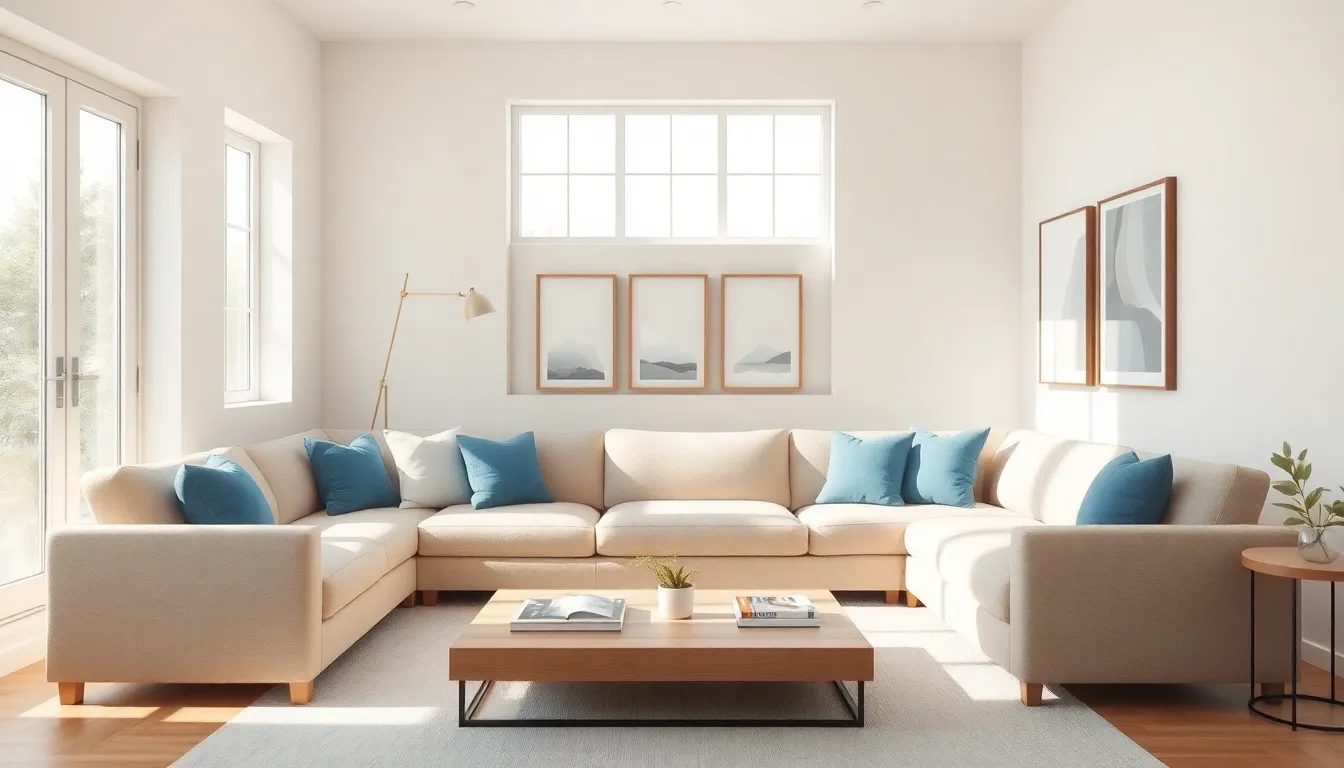In a world overflowing with clutter and chaos, the minimalist living room emerges as a serene oasis. Imagine a space where every piece of furniture serves a purpose and every decorative item sparks joy—yes, it’s possible! Minimalist interior design isn’t just about less; it’s about making smarter choices that elevate your living space while keeping your sanity intact.
Gone are the days of wrestling with piles of throw pillows and endless knick-knacks. Embracing a minimalist aesthetic can transform your living room into a chic retreat that’s both functional and stylish. It’s time to say goodbye to the clutter and hello to a fresh, airy vibe that invites relaxation. So grab a cup of coffee, kick back, and discover how to create a minimalist living room that’ll make your friends wonder if you’ve hired a designer or just found your inner zen.
Table of Contents
ToggleUnderstanding Living Room Minimalist Interior Design
Living room minimalist interior design focuses on creating tranquil spaces that prioritize simplicity and intentionality. Every element serves a purpose, allowing for a clean and organized environment.
Key Principles of Minimalism
Minimalism revolves around a few key principles that define its aesthetic. Emphasis on functionality contributes to a space’s efficiency. Clean lines characterize the furniture and decor, ensuring an uncluttered appearance. Neutral color palettes promote calmness and harmony, while curated selections of decor maintain visual interest. Open spaces enhance light flow and create an airy atmosphere, supporting an overall sense of relaxation.
Importance of Functionality and Simplicity
Functionality plays a crucial role in minimalist design. Each piece of furniture deserves a specific function, minimizing excess. Simplicity aids in focusing on essential items that evoke joy or serve a necessary purpose. Streamlined layouts help eliminate distractions, allowing occupants to engage more with their surroundings. Choosing versatile pieces maximizes utility, ensuring that the living space adapts to daily needs while remaining aesthetically pleasing.
Choosing the Right Color Palette

Selecting an appropriate color palette sets the tone for a minimalist living room. Choices should reflect calmness and purpose, enhancing the serene atmosphere.
Neutral Tones for a Calm Atmosphere
Neutral tones define the foundation of minimalist design. Shades such as white, beige, gray, and taupe promote tranquility and create an airy feel in any space. They also allow for effortless integration of different textures and materials, while keeping the focus on functional furnishings. Each neutral hue serves as a backdrop, ensuring that essential elements stand out without overwhelming the senses. Additionally, these tones create a cohesive look that flows throughout the room, making it feel more spacious and inviting.
Incorporating Accent Colors
Accent colors bring personality and warmth to minimalist interiors. Select hues that complement the neutral base without dominating the space. Soft blues, muted greens, or gentle pastels evoke freshness and maintain a balanced atmosphere. Strategically placed accessories, such as throw pillows or artwork, enhance visual interest without cluttering. Careful consideration of these accent pieces adds depth while remaining true to the minimalist ethos. They encourage expression and reflection, fostering a warm and inviting environment.
Selecting Furniture for Minimalist Spaces
Choosing furniture for a minimalist living room focuses on functionality and simplicity. Careful selection enhances both aesthetics and utility.
Multi-Functional Furniture
Multi-functional furniture plays a vital role in minimalist design. Items like coffee tables with storage or sofas that convert to beds maximize space. They provide solutions for everyday needs while minimizing clutter. Versatile pieces allow for adaptability in various situations and help maintain an open layout. Options such as nesting tables or ottomans with hidden compartments offer further utility without overwhelming the room. Embracing these pieces creates a seamless blend of style and purpose.
Essential Pieces for a Minimalist Living Room
Essential pieces form the backbone of a minimalist living room. Sofas, accent chairs, and coffee tables stand out as key components. Each item should be thoughtfully chosen for both comfort and design. Emphasis lies on clean lines and neutral colors, which fit the overall aesthetic. Incorporating a single statement piece, such as an artful coffee table or a unique chair, fosters visual interest. Additionally, a well-placed area rug can define the space while adding texture. Selecting the right essentials promotes harmony, inviting relaxation into the living area.
Accessorizing Without Clutter
Accessorizing in a minimalist living room requires intentional choices. Each item should serve a purpose while enhancing the space’s aesthetic.
Focal Points in Minimalist Design
Focal points create visual interest in a serene environment. A single artwork, a well-placed plant, or a unique light fixture can draw attention without overwhelming. Such elements stand out against a neutral backdrop, establishing a cohesive theme. Choosing one standout piece helps maintain simplicity while adding character, making it essential for a balanced design.
The Role of Textures and Materials
Textures contribute depth to minimalist spaces. Incorporating a variety of materials, such as wood, metal, and fabric, enhances visual appeal. Soft textiles like cushions or throws invite comfort without adding clutter. Natural materials bring warmth, while sleek surfaces maintain a modern look. Balancing these elements fosters a harmonious environment, ensuring the space remains elegant and inviting.
Tips for Creating a Minimalist Living Room
Creating a minimalist living room involves intentional design choices. Prioritizing space and layout enhances the overall effect.
Space Planning and Layout
Space planning focuses on arrangement. Start by measuring the room to understand available dimensions. Select furniture that complements the space, ensuring balance and flow. Place larger pieces against walls to maximize open areas, allowing for movement. Utilize a central focal point, such as a coffee table or a striking piece of art, to draw the eye. Keep pathways clear, promoting accessibility and comfort. Simple layouts with ample negative space create a serene atmosphere, fostering relaxation and clarity.
Tips for Decluttering
Decluttering transforms a chaotic room into a calm environment. Begin by evaluating each item for value and functionality. Remove duplicates, broken items or those that don’t fit the minimalist aesthetic. Implement storage solutions, like stylish baskets or hidden compartments, to conceal seldom-used items. Donate or discard items to create a sense of space. Limit decorative accessories to a few thoughtfully chosen pieces that spark joy. Regularly revisit your belongings to maintain a clutter-free atmosphere, supporting a continually inviting setting.
Embracing minimalist interior design in the living room can lead to a more serene and functional space. By focusing on essential items and thoughtful choices, individuals can create an environment that promotes relaxation and clarity. The right color palette and carefully selected furniture enhance both aesthetics and utility, ensuring the room remains inviting yet uncluttered.
Incorporating textures and statement pieces adds depth without overwhelming the senses. Ultimately, adopting a minimalist approach not only transforms the living room into a chic retreat but also fosters a lifestyle centered around simplicity and intentionality. This design philosophy encourages individuals to cherish their space and the items within it, making every moment spent in the living room a joyful experience.



